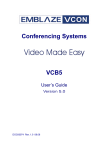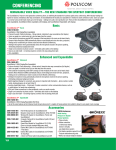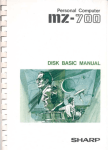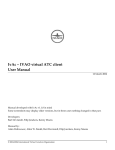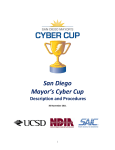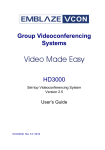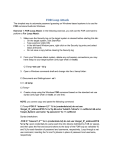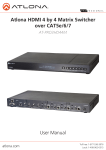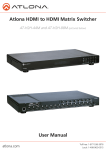Download Emblaze-VCON VCB5 User`s guide
Transcript
Top Conferencing Systems VCB VCBPro Getting Started Guide Version 6.0 DOC00079 Rev. 6.0 09.07 ii Emblaze-VCON VCB User’s Guide © 2007 Emblaze-VCON Ltd. All Rights Reserved. Information in this document is subject to change without notice. No part of this document can be reproduced or transmitted in any form or by any means electronic or mechanical - for any purpose without written permission from Emblaze-VCON Ltd. Media Xchange Manager is a registered trademark of Emblaze-VCON Ltd. All other product names are trademarks or registered trademarks of their respective companies or organizations. Limited Warranty Emblaze-VCON Ltd. warrants that SOFTWARE will perform according to accompanying user documentation for a period of 90 (ninety) days from the date of receipt; replacement SOFTWARE will be warranted for 90 (ninety) days from the date of receipt. This Limited Warranty shall not apply to any product that in the opinion of Emblaze-VCON Ltd. has not been installed or upgraded according to accompanying documentation from Emblaze-VCON Ltd. or been subject to misuse, misapplication, negligence or accident while in the hands of the purchaser. GRANT OF LICENSE Emblaze-VCON Ltd. grants the Purchaser a non-exclusive and non-transferable license to use the SOFTWARE product and to make one copy solely for backup or archival purposes, which may include user documentation provided via online or other electronic form. Additional copies may not be made nor may anyone else be allowed to copy or otherwise reproduce any part of the licensed software without prior written consent of Emblaze-VCON Ltd. COPYRIGHT All trademarks(s), logo(s), name(s), software, documentation and other supporting materials relating to the Product are trademarked, copyrighted or owned by Emblaze-VCON Ltd. as proprietary information protected by United States copyright laws and international and applicable national treaty provisions and laws. Software protection extends beyond its literal code to structure, sequence and organization; any unauthorized use or modification would constitute a misappropriation of Emblaze-VCON’s proprietary rights and a violation of the License agreement. LIABILITIES Emblaze-VCON’s entire liability and the Purchaser’s exclusive remedy shall be at Emblaze-VCON’s option, either return of the price paid or repair/ replacement of the Product not meeting Emblaze-VCON’s declared Limited warranty. Emblaze-VCON or its suppliers shall not be liable in any event to anyone for any indirect, incidental, consequential, special or exemplary damages including without limitation damages for loss of business profits, business interruptions, business information or other pecuniary loss arising out of the use of or inability to use the said Product even if advised of the possibility of such damages. In any case, Emblaze-VCON’s entire liability under any provision of this agreement shall be limited to the amount actually paid by the Purchase for the Product. Emblaze-VCON VCB User’s Guide iii Emblaze-VCON Technical Support This Getting Started Guide was designed to help you set up and work with your VCB easily so that you can enjoy its many features. This User’s Guide was designed to help you set up and work with your VCB easily so that you can enjoy its many features. If a situation occurs that is not covered by the supplied documentation, contact your local Emblaze-VCON distributor, and request assistance from their Emblaze-VCONtrained technical support department. Please describe the problem, device, and PC operating system (if applicable), and any other relevant details. Also, you may access the Technical Support section of the Emblaze-VCON website (http://www.emblaze-vcon.com/support/index.shtml) in order to check its knowledge base or initiate other customer support processes: Page iv Type of support Support Notes Troubleshoot or receive technical information about specific Emblaze-VCON products. Downloads Download a new software release or a free product evaluation. Demo Numbers Test your videoconferencing system. License Key Requests Request a permanent license key for your organization’s MXM(s). Emblaze-VCON VCB User’s Guide Table of Contents TABLE OF CONTENTS Top ...................................................................................................................... i Limited Warranty ................................................................................................ iii Emblaze-VCON Technical Support..................................................................... iv Table of Contents .................................................................. 3 1 Welcome to the VCB.............................................................. 1 1.1 Introduction..................................................................................................1 1.2 Package Contents ........................................................................................ 3 2 Defining the VCB IP Configuration ......................................... 5 2.1 Retrieving VCB initial IP configuration ...................................................... 5 2.2 Assigning a Static IP Address to a VCB with DHCP address...................... 7 3 Logging into the VCB........................................................... 11 4 Setting Up the VCB.............................................................. 15 4.1 VCB Settings ...............................................................................................15 MCU Settings..............................................................................................15 Administrators List ....................................................................................18 4.2 VCB Services Configuration ...................................................................... 20 General........................................................................................................21 Layouts ...................................................................................................... 24 Media ......................................................................................................... 26 QoS............................................................................................................. 29 Advanced ................................................................................................... 30 4.3 VCB System Upgrade & Restore ............................................................... 32 Upgrading VCB.......................................................................................... 32 VCB Restart / Shutdown ........................................................................... 33 VCB Backup/Restore................................................................................. 34 System Restore .......................................................................................... 35 Take Snapshot ........................................................................................... 36 4.4 VCB registration to Remote MXM ............................................................ 37 5 Setting Up a Dedicated VCB Service ................................... 39 5.1 Dedicated Service for End Points.............................................................. 39 5.2 Dedicated Service for a Zone......................................................................41 6 Adding the VCB to an Ad-hoc Permission Group ................ 43 6.1 Ad-hoc Permission Group Properties ....................................................... 44 General....................................................................................................... 44 Permission Group...................................................................................... 45 7 Ad-Hoc Conferencing .......................................................... 47 Emblaze-VCON VCB6 Getting Started Guide 3 7.1 7.2 7.3 7.4 Inviting from vPoint™/vPoint HD ........................................................... 47 Inviting from HD3000/2000/1000/600................................................. 48 Inviting from HD5000/4000 ................................................................... 49 Inviting from Other H.323 Videoconferencing Applications ................... 50 8 Chair Control During Conferences........................................ 51 9 Upgrading the VCB License Key........................................... 57 10 SSH Commands .................................................................. 59 10.1 Descriptions of SSH Commands .............................................................. 59 1 Welcome to the VCB 1 WELCOME 1.1 TO THE VCB Introduction The VCB, Emblaze-VCON’s premier Multipoint Conferencing Unit (MCU), enables: T Initiation and management of multipoint conferences, including both scheduled and ad-hoc conferences, which are multipoint sessions that were expanded from point-to-point calls. T Wide range of rich, dynamic layouts for the simultaneous viewing of several participants. Up to 25 users may be displayed at the same time. T Web-based management/configuration, videoconference scheduling/ moderating and Reporting applications. T Simultaneous multicast streaming of active conferences and multimedia to multiple passive participants. The VCB includes advanced features, such as video and audio transcoding, support of high definition video resolutions, as well as basic features such as continuous presence, presenter mode, password-protected conferences and voice-activated switching. Emblaze-VCON Guide 1 1 Welcome to the VCB The VCB includes the Conference Moderator, which provides administrators and users with the ability to schedule conferences in advance, also from within MS Outlook, and to manage them remotely. At the appointed time, the Conference Moderator initiates the conference and connects the conference participants. Conference hosts can also control when participants join or exit sessions, and transmit video and data streams to the participants. For more details, see the Conference Moderator Help. The VCB’s robust Chair Control provides several options for displaying conference participants. A rich selection of predefined layouts expands on the traditional methods of Continuous Presence and Voice-activated Switching. Additionally, conference organizers can choose among the following view switching modes for each session: Lecture Showing the Lecturer in full screen mode for all participants. Lecturer see a pre-defind Continuous Presence layout of all participants. Dominant Speaker Showing the most recent speakers in the conference or from within predefined groups. Fixed Image Showing specific views throughout the conference’s duration. Timer Image Showing a rotation of Continuous Presence views, changing at timed intervals. The VCB supports the following: T H.261/H.263/H.263+/H.263++/H.264 video transcoding support in Voiceactivated Switching and in Continuous Presence. T G.711, G.722 and G.722.1 Annex C, G.723.1, G.728, G.729 and AAC-LD audio algorithms with audio transcoding, allowing users to participate in a multipoint conference using different audio standards. T Up to 4 Mbps data rate per participant in Voice-activated Switching and in Continuous Presence. T Dial-in conference initiation. T Password protected conferences. T Voice notifications in different languages. T Handles calls connecting up to 48 concurrent users. T Support for sessions including H.323 end points/devices and SIP User Agents (through the MXM's embedded SIP proxy server). T Multi-point sessions can be joined (cascaded) onto other sessions. 2 Emblaze-VCON Guide 1 Welcome to the VCB T Applies H.239 support with HD DualStream™, in which both video and data application-sharing may be transmitted to conference participants (whose end points support dual streams). End points that don’t support dual streams will receive either the data or video stream, depending on the active VCB Service’s configuration. T H.239 streams may be sent in CIF, 4CIF, VGA, SVGA, or XGA. T Mode switching, allowing participants to choose the type of viewing mode (Dominant Speaker, Fixed Image or Timer Mode) during a conference. T Symmetric bandwidth usage during Continuous Presence calls. T Protection of calls using H.235 (AES) encryption. T Optional deployment of Emblaze-VCON vPoint HD videoconferencing clients. 1.2 Package Contents When you open the VCB shipping package for the first time, check that the following items are included. If any of the items (according to your Customer Order) are missing or damaged, contact your Emblaze-VCON representative immediately. • • • • • • VCB Server unit Power cables (2) Network cable Crossover cable User Guide and Utilities CD-ROM Getting Started Guide Emblaze-VCON Guide 3 2 Defining the VCB IP Configuration 2 DEFINING THE VCB IP CONFIGURATION Before you can use the VCB for the first time, you have to define a unique IP configuration for it. This task is made up of the following procedures: T Retrieving the VCB’s initial IP configuration T Changing the IP configuration to unique settings, such as a static IP address Connect to any one of these interfaces. Interface GbE0 has a fixed static IP which cannot be changed. For standard operation, we recommend that you connect one NIC/one interface. If nevertheless, you require connection through more than one NIC, each NIC must belong to a different subnet. Connect a network cable to the interface you configured only after completing the configuration. 2.1 Retrieving VCB initial IP configuration The following procedure describes how to get the IP address from the VCB unit’s front panel. 1 Connect a network cable to any one of interfaces GbE1 to GbE3. 2 Turn the VCB unit on. A welcome message appears in the LCD display. Emblaze-VCON Guide 5 2 Defining the VCB IP Configuration 3 In the LCD display, press an arrow button until the GET IP command appears. Press the Enter button. 4 Press an arrow button again until the connected network card and interface appears (NIC 1 to NIC 3 = GbE1 to GbE3) and press the Enter button. The VCB unit receives an IP address from the DHCP server. Select NIC: 1 172.20.21.22 If a cable is not connected to the interface, 0.0.0.0 appears in the display. 5 6 Leave the cable connected to the chosen interface. Emblaze-VCON Guide 2 Defining the VCB IP Configuration 2.2 Assigning a Static IP Address to a VCB with DHCP address This procedure describes how to set static IP Address when the VCB is connected to the network and has aquired a DHCP adrress. From a remote computer connected to the network, connect to the VCB Configuration application, EVCAdmin, using web browser. 1 Open web browse and in the address field, enter the EVCAdmin URL: <IP Address>/EVCAdmin. 2 EVC Home page loads. Click on the EVCAdmin section. 3 Enter login name and password. Default name is su and default password is 1234. 4 Under the VCB tab, click on Network. 5 A list of all network interfaces is displayed. 6 Select a different NIC than the one you are currently connected to. Click on its name to open the configuration page. Emblaze-VCON Guide 7 2 Defining the VCB IP Configuration 7 Assign static IP by entering IP Address, Subnet Mask and Default Gateway. DNS Server is optional. The configured NIC has to be different than the one you are currently connected to. 8 Check the Aupdate Configuration Files checkbox for all VCB modules to be be updated with new IP configuration. 9 Click Apply. 10 Connect a network cable to the configured NIC. Check the correct IP Address has been set through the LCD display. 8 Emblaze-VCON Guide 2 Defining the VCB IP Configuration 2.3) Assigning a Static IP Address to the VCB through interface GbE0 This procedure describes how to set static IP Address while connecting to Factory Default GbE0. 1 Connect a crossover cable between interface GbE0 and a computer. This interface’s IP configuration is: IP address 10.0.10.10 Subnet mask 255.255.0.0 Gateway IP address 0.0.0.0 Connect to GbE0. 1 To access the VCB unit from another computer initially, the two systems must, at least temporarily, belong to the same network segment. That is, the first three fields of the address and the subnet mask must be identical. Write down the computer’s current IP address and subnet mask so that you can restore them later. Change the remote computer’s IP configuration temporarily to the same IP address segment(10.0.10.x) and subnet mask listed in step 1. 2 On the computer, open web browse and in the address field, enter the VCB’s IP address. 3 EVC Home page loads. Click on the EVCAdmin section. 4 Enter login name and password. Default name is su and default password is 1234. 5 Under the VCB tab, click on Network. 6 A list of all network interfaces is displayed. 7 Select NIC interface. Click on its name to open the configuration page. Emblaze-VCON Guide 9 8 Assign static IP by entering IP Address, Subnet Mask and Default Gateway. DNS Server is optional. 9 Click Apply. 10 Connect a network cable to the configured NIC. Check the correct IP Address has been set through the LCD display. 3 Logging into the VCB 3 LOGGING INTO THE VCB When you start the VCB program, you must first log in. Emblaze-VCON’s Media Xchange Manager® (MXM) provides gatekeeper functions for the VCB. The MXM manages the videoconferencing environment among end points registered in it, including multipoint conferencing managed by the VCB. ³ To log in to the VCB 1 In your web browser, enter the URL of your VCB. The Login page appears. Logging Into the VCB 2 Enter your login name and password. The factory-defined login configuration is: User Name su Password 1234 3 If necessary, define the following: Remember Login Name and Password Select to allow the system to use the same login values in the future. Language Language of the management program. Force Login If a user with the same Login Name is already connected from a different location, this login attempt will succeed, disconnecting the other user. 4 Click Login. Emblaze-VCON Guide 11 3 Logging into the VCB 5 Click the VCB tab to enter the VCB Configuration pages. VCB Configuration is divided into Settings, Services, Network and System. VCB Settings - MCU Details 12 Emblaze-VCON Guide 3 Logging into the VCB 6 When you have more than one VCB registered to the MXM running on the server you are currently connected to, these VCB’s are listed in the left pane of the page. clicking on a specific VCB will show its details and will allow you to configure it. 7 Network settings like IP address, Date and Time and also recovery of the VCB server can be done only by connecting directly to this specific VCB server. VCB Settings - MCU Details Emblaze-VCON Guide 13 3 Logging into the VCB 14 Emblaze-VCON Guide 4 Setting Up the VCB 4 SETTING UP THE VCB This chapter provides instructions for setting the VCB configuration in the VCB Configuration program, and describes the properties so that you can set up the most suitable configuration for your installation. 4.1 VCB Settings The Settings tab contains general device configuration. These appear under the MCU Settings and Administrators categories. MCU Settings ³ To display MCU Settings 1 After logging in, click the Settings tab and then MCU Details. 2 On this page, you can edit the parameters listed below. The other parameters are read-only and cannot be edited in the VCB Configuration program (for descriptions, see page 16). Description Identity of the VCB. This name will appear in the MXM Administrator after the login process is finished. Location Physical location of the VCB. Gatekeeper Address IP address of the MXM or H.323 gatekeeper. Defaults Click to restore the default port configuration. RTP Ports Start At The lowest port number allocated for video and audio during videoconferences. This allocation meets the Real-Time Protocol (RTP) and Real-Time Control Protocol (RTCP) specifications, which enable applications to synchronize and spool audio and video information. H.245 Port Range The lowest port number allowed for end-to-end signalling of multimedia during videoconferences This allocation provides for H.245 functions, such as capability exchange, signalling of commands and indications, and messages to open and fully describe the content of logical channels. Emblaze-VCON VCB Getting Started Guide 15 4 Setting Up the VCB To implement the changes, click Apply. 3 I In the MCU Settings tab, the following properties are read-only: 16 Network Address IP address of the VCB. Vendor ID Identity of the manufacturer. Product ID Manufacturer's identity of the product. Version ID Manufacturer's version identification of the product. Emblaze-VCON VCB Getting Started Guide 4 Setting Up the VCB Build Number Version information for the VCB. Licensed Ports Maximum number of concurrent participants that may be serviced by in this VCB. Last Log On Most recent date that the VCB logged in to the MXM or H.323 gatekeeper. Last Log Out Most recent date that the VCB logged out of the MXM or H.323 gatekeeper. If the Last Log On date is later than the Last Log Out date, the selected node is currently logged into the MXM. Emblaze-VCON VCB Getting Started Guide 17 4 Setting Up the VCB Administrators List The Administrator tab lists administrators with permission to work with the VCB. ³ To display the list of Administrators T In the upper bar , click Administrators tab. List of Administrators ³ 18 To Add New Administrator 1 Click on the Add button at the bottom of the page. 2 A new administrator is created with a default name and a default password of 1234. 3 Select the new administrator and change its name. Click Apply. 4 Go to the Security tab and set administrative level and change the password. Click Apply. Emblaze-VCON VCB Getting Started Guide 4 Setting Up the VCB ³ To change an Administrator password 1 In the left pane, click the Name of the Administrator you want to change password to. Click on the Security tab. Changing Administrator Password 2 In the Security tab, do the following: To keep the same password, leave the Password boxes blank. New Password Type a new password for the administrator. Confirm the Password 3 Type the new password again. Click Apply. Emblaze-VCON VCB Getting Started Guide 19 4 Setting Up the VCB 4.2 VCB Services Configuration VCB Services define the usage of resources used during a multipoint videoconference managed by the VCB. After the VCB's installation, you can add or edit service entries. One directory number (E.164) is created for each service type. To handle situations in which additional participants require additional resources, set up several VCB Services with incremental increases in bandwidth, number of ports, or multicast capabilities. List of VCB Services ³ To add a VCB Service T ³ To edit a VCB Service 1 2 3 20 At the bottom of the list of services, click Add. A new VCB Service entry appears in the list with the default configuration. Click the name of the VCB Service in the Description column. The Service Configuration page opens. The Configuration includes the following categories (each in its own tab on the page). — General — Layouts — Media — QoS — Advanced Change properties according to your service specifications, or keep the default settings. When you finish each page, click Apply to implement the changes. For explanations about the various properties, see the following subsections. When you finish editing the configuration, click List to return to the Services list. Emblaze-VCON VCB Getting Started Guide 4 Setting Up the VCB ³ To delete a VCB Service 1 Click the checkbox to the left of the VCB Service entry. 2 Click Delete. 3 Click OK to confirm. The following subsections describe the VCB Service properties. General In the General page, enter identity information of the VCB Service. VCB Service - General Emblaze-VCON VCB Getting Started Guide 21 4 Setting Up the VCB In the General tab, the following properties appear: Number Number to be dialed for using this service. Description Name of the service. This name identifies the service in the VCB Services List. Max Number of Participants The maximum number of concurrent calls allowed in this session, according to your VCB’s license terms. Reserve Ports If selected, the VCB reserves an equal number of ports as the number of maximum users in this session, in accordance with your VCB license terms. For example, if the session is limited to a maximum of 8 participants, the VCB will reserve 8 ports. None of those ports will be available for other sessions. Optimize for number of participants The number of participants that VCB will optimizie resources for. for example, If there are going to be only 5 participants in a conference, VCB will divide its resources so that each one of these 5 participants will receive the best video quality his VC system can handle. Conference Bandwidth Maximum bandwidth available for each participant. Ad-Hoc Select to enable expansion of this service to an Ad-Hoc conference. Enable Voice Notifications Enable voice notifications to be played when participants join the conference, participants leave the conference and when dialing a password protected conference. Notification Language Select the language in which notifications will be played. Service Password / Confirm Password A conference can be password protected to ensure that only authorized participants can connect to it. Password has to contain 4 to 8 numeric charachters. Confirm password to validate it. Multicast Select to enable streaming sessions. Session Name Type a name to identify this service’s multicast streaming session. Session Description Type a name or description of the multicast session. Media Formats Select the video and audio codecs and the video resolution in which the multicast streaming session will be transmitted. 22 Emblaze-VCON VCB Getting Started Guide 4 Setting Up the VCB Audio Codec Select the Audio codec for the multicast streaming session. Video Codec Select the Video codec for the multicast streaming session. Video Size Select the resolution in which the multicast video will be transmitted. Broadcast to Address The destination IP address for the multicast session. All participants in the session transmit and receive from this common IP address. This address must be a class D address in the range of 224.0.0.0 to 239.255.255.255. Video Refresh Rate Define the interval at which the end point broadcasting the multicast synchronizes the video display at the receiving ends. Media Packets TTL The maximum number of routers (hops) that the multicast session's packets may pass through. SDP Rate Session Description Protocol Rate - The interval at which announcements and descriptions of the multicast session are sent out on the Internet Multicast backbone (Mbone), for Participants and passive third-party viewers. SDP TTL The maximum number of routers (hops) that the SDP announcement for this session may pass through. Emblaze-VCON VCB Getting Started Guide 23 4 Setting Up the VCB Layouts In the Layouts tab, define the layout for displaying multiple users on the screen at the same time. VCB Service - Layouts Choose the type and if necessary, scheme for the layout: Display one user at a time. Display up to four users at a time. Display changes automatically depending on the number of users in the conference. 1->2->3->2*2->3*3->4*4 1 = 1 user 2 = 2 users 3 = 3 users 2*2 = 4 users in 2 rows 3*3 = 5-9 users in 3 rows 4*4 = 10-16 users in 4 rows. 5*5 = 16-25 users in 5 rows. 2->2+8 When over 2 users participate, one row of 2 users and another row of 8 windows open; each additional user appears in a window and unused windows remain empty. 24 Emblaze-VCON VCB Getting Started Guide 4 Setting Up the VCB 1->1+5->1+7 1=1 user 1+5=2-6 users 1+7=7-8 users. Display users in the same layout scheme regardless of the number of the users in the call. In the Schema list, choose the layout. Emblaze-VCON VCB Getting Started Guide 25 4 Setting Up the VCB Media The Media tab contains the settings for audio formats, video formats and dual-video streaming. VCB Service - Media Audio In the Audio list, select the codecs that are available for conferences using this specific VCB Service. Participants can use any Audio codec. Checking all or specific audio codecs will make VCB to mix (transcode) these codecs. Video Video Codecs 26 The video codecs (H.261, H.263, H.264) used in the conference. Checking 2 or all video codecs will make VCB to mix (transcode) these codecs and will enable participants to join the conference at their system’s best capabilities. Emblaze-VCON VCB Getting Started Guide 4 Setting Up the VCB Max Resolution The size of the transmitted video images in outgoing Out direction: Keep Aspect Ratio • 720p (VCBPro Only) - is a short name for a category of High Definition video modes. The number 720 stands for 720 lines of vertical display resolution, while the letter p stands for progressive scan or noninterlaced. • • 4CIF - uses 704 x 576 pixels resolution. CIF - (Common Interchange Format), or normal size. CIF uses 352 X 288 pixels resolution. Check this option to keep the original aspect ratio of connected sites. Otherwise, VCB will stretch the video image to fit the layout window. Dual Video End points that support Emblaze-VCON’s HD DualStream™ (vPoint HD, HD5000, HD4000, HD3000 and HD2000) or other dual-video capability can send video and data streams simultaneously to a multipoint conference through the VCB. During a conference, end points supporting HD DualStream can view documents, graphics, and presentations as the main image, while the video appears as a PIP inset on the screen. Format The video codec (H.261, H.263, H.264) used by the streaming source. Video Format/ Size The format and resolution of the transmitted video images. The available formats are: T CIF (Common Interchange Format), or normal size - 352x288 T VGA - (Video Graphics Array) 640x480 T 4CIF (4 x CIF) - 704x576 T SVGA (Super Video Graphics Array) - 800x600 T XGA (Extended Graphics Array) - 1024x768 Emblaze-VCON VCB Getting Started Guide 27 4 Setting Up the VCB Send second video channel to legacy devices If a receiving end point does not support dual streams, it receives only the stream carrying the shared data application. However, the data appears in video format. When If data sharing takes place during a multicast conference, streaming send the multicast session’s Participants receive the data second video stream only. channel 28 Emblaze-VCON VCB Getting Started Guide 4 Setting Up the VCB QoS The QoS tab contains properties for controlling the type of Quality of Service that will be used for transmitting packets during a multipoint conference that’s initiated using this VCB Service. VCB Service - QoS Priority Type (QoS) Select the type of QoS used for transmitting packets during heavy network congestion conditions. No Priority Network transfers packets using normal Best-effort (or Routine) packet transmission. IP Precedence Network gives priority to certain types of bits (video, audio, control) according to the eight levels of IP precedence. Diffserv Network transfers packets according to specific needs of the sending application. Emblaze-VCON VCB Getting Started Guide 29 Priority Values Video, Audio and RTCP Priority For each packet type, select an appropriate priority level. The item with the highest priority number will be sent first, the item with the next highest number will be sent second, and so on. The priority levels vary, depending on whether the selected Priority Type is IP Precedence or Diffserv. Defaults Click to restore the default QoS configuration. Advanced In the Advanced page, define additional parameters required by the VCB for managing multipoint conferences. VCB Service - Advanced Defaults Click to restore the default configuration for the associated set of parameters. 4 Setting Up the VCB Encryption Method Choose the mode of encryption for conferences using this service. T Choose None to allow unsecured calls. T Auto enables the transmitting end point to encrypt a call if the remote sides have also enabled encryption. If they have not enabled encryption, an outgoing call will be unsecured. T AES (Advanced Encryption Standard) is a common encoding method for encrypting data transmissions. Select this option to encrypt all calls using this VCB Service. If the remote sides have not also enabled encryption, the call attempt will be unsuccessful. Voice-activated Delay period before changing the displayed video during Switching a voice-activated switching multipoint conference. The Delay displayed video changes only after the source of the new sound or voice is steady for the defined period. A delay period is necessary to prevent quick incoherent display changes that may be caused by sudden noises (such as a sneeze) rather than a steady speaker. Enable FECC Select to enable Far End Camera Control (FECC) to all participants in a conference using this service. Applicable only to Voice-activated Switching mode. Enable Active Speaker Highlight Select to display a frame surrounding the active speaker in Continuous Presence layouts. Enable On Screen Display Select to display the names of the displayed users in Continuous Presence layouts. Maximum Packet Size Set this parameter either equal to or lower than your network’s MTU. Audio/Video/ Smooth playback of transmitted media continues even if Data Jitter Size the packets arrive out of order at the receiving end, up to the number of packets defined here for each packet type. Emblaze-VCON VCB Getting Started Guide 31 4 Setting Up the VCB 4.3 VCB System Upgrade & Restore VCB Sytem tab define system upgrade process and Backup & Restore of the VCB server. Upgrading VCB upgrading VCB 1. Save the upgrade package (upgrade.exe) you received from Emblaze-VCON to the local hard drive or network resource. 2. Click on the System tab and open the Upgrade page. 3. Click the Browse button and browse to the upgrade package location. 4. Click the Apply button. 5. At the end of the upgrade process, VCB will restart. VCB Version number can be verified at the Settings tab, MCU Details page. 32 Emblaze-VCON VCB Getting Started Guide 4 Setting Up the VCB VCB Restart / Shutdown VCB Restart / Shutdown Restart Restart VCB server. The EVCAdmin application will be unavailable and you will have to login again. Shutdown Shutdown VCB server. Turn it on again from the power button on the front panel. Emblaze-VCON VCB Getting Started Guide 33 4 Setting Up the VCB VCB Backup/Restore VCB supports a system backup and restore functionality to help recover immediately the system in cases of disaster. The Backup and Restore functionality saves the baseline (Factory Default) configuration, creates a new snapshot of VCB configuration once a week for 10 weeks and allows you to manually create snapshots according to configuartion changes. At any time, you can easily restore the default VCB configuartion (as was set at EVC) or return to a specific configuration state. Action Choose the Action you want to perform: System restore Restore system configuration to previously saved snapshot. Snapshot can be a baseline (Factory defaults), periodic snapshots that are created automatically by the VCB, or a snapshot that was previously created by system administrator. Take Snapshot 34 Take a snapshot of current VCB Configuration. It is recommended to take snapshots everytime a configuration change is done, like adding new services, scheduling new meetings, etc. Emblaze-VCON VCB Getting Started Guide 4 Setting Up the VCB System Restore Choose the Restore option and click the Apply button: System restore Options Restore To Baseline Restore system configuration to factory default snapshot (baseline) or a newly created baseline. Baseline is the basic snapshot that the system can be restored to at any time. Restore To Last Restore system configuration to the latest snapshot Snapshot created by the system. VCB creates a new snapshot once a week. Restore To Date Restore system configuration to a snapshot that was taken in a specific date. For example, if configuration changes were made and you want to restore VCB configuration to the state before these changes. Restore To Restore system configration to a specific snapshot that Snapshot From was created previously. Each snapshot represent a List different configuraton state. Password Enterpassword for VCB backup and restore actions to ensure only authrized administrators can restore the VCB configuration. default password is 1234. Emblaze-VCON VCB Getting Started Guide 35 4 Setting Up the VCB Take Snapshot After configuration changes of the VCB like changing network settings, adding or deleting services, registering new users to gatekeeper and as a periodic backup task, it is recommended to take a snapshot of VCB configuration. Take snapshot 1. Enter name of snapshot. This name will be listed later in the Snapshot From List box for restore. 2. Enter a snapshot description. The description will describe configuration state of the VCB. 3. Enter Password to protect the snapshot and to ensure that only authorized administrators can restore to this snapshot. 36 Emblaze-VCON VCB Getting Started Guide 4 Setting Up the VCB 4.4 VCB registration to Remote MXM You can register and manage multiple VCB’s to one central. Register to MXM For registering VCB to remote MXM: 1. Open the VCB EVCAdmin application by typing the VCB’s IP Address in an Internet browser address bar. 2. Login using the Administrator’s user name and password. 3. Click on the System tab and than on MXM. 4. Enter the IP address of the MXM you wish to connect to. Emblaze-VCON VCB Getting Started Guide 37 4 Setting Up the VCB 38 Emblaze-VCON VCB Getting Started Guide 5 Setting Up a Dedicated VCB Service 5 SETTING UP SERVICE A DEDICATED VCB The tasks described in this chapter are procedures which you perform in Emblaze-VCON’s Media Xchange Manager® (MXM) Administrator application. 5.1 Dedicated Service for End Points A dedicated VCB service is set up only for expansion to an ad-hoc conference that includes a specific end point. That is, the service is “dedicated” to that end point. That specific end point must be either one of the original two end points of a pointto-point conference or the invited end point. ³ To dedicate a service to a specific end point 1 In the MXM Administrator, double-click the VCB Service and then click the Session tab. 2 Select Use this service as an adhoc conference resource and then click OK (in addition, you may also set the service to be exclusive for ad-hoc conferences only). Emblaze-VCON VCB User’s Guide 39 5 Setting Up a Dedicated VCB Service 3 4 40 Double-click the end point, click MXM, and then click the MCU Services tab. In the Dedicated MCU Service list, select the service. Click OK. Emblaze-VCON VCB User’s Guide 5 Setting Up a Dedicated VCB Service 5.2 Dedicated Service for a Zone A dedicated ad-hoc service for a neighboring zone may be used only if any of that zone's end points are in the resulting ad-hoc conference (either one of the original two end points of the conference or the invited end point). ³ To dedicate a service to a specific end point 1 In the MXM Administrator, double-click the VCB Service and then click the Session tab. 2 Select Use this service as an adhoc conference resource and then click OK (in addition, you may also set the service to be exclusive for ad-hoc conferences only). 3 Double-click the neighboring zone and then click the MCU Services tab. 4 In the Dedicated MCU Service list, select the service. Click OK. Emblaze-VCON VCB User’s Guide 41 6 Adding the VCB to an Ad-hoc Permission Group 6 ADDING THE VCB TO PERMISSION GROUP AN AD-HOC The tasks described in this chapter are procedures which you perform in Emblaze-VCON’s Media Xchange Manager® (MXM) Administrator application. An Ad-hoc Permission group is a set of VCB services that are defined for use in adhoc conferences. It helps you control the use of resources for expanding to ad-hoc conferences. An Ad-hoc Permission group may consist of one service or multiple services. It may also include combinations of services from more than one registered VCB unit. The order in which services are requested is important and controllable by Super Userlevel administrators. During expansion to an ad-hoc conference, the MXM only uses those services listed in the inviting end point’s assigned permission group. After an invitiation is initiated, the MXM first tries to use the first service defined in the permission group. If the first service is not available, it tries to use the second defined service, and so on. If all enabled services are unavailable, the MXM does not complete the "invitation" to the additional end point. By default, every registered end point is assigned to the default Ad-hoc Permission Group. This may be changed when manually adding a new end point, or by editing the end point’s properties. ³ To add an Ad-hoc Permission Group 1 In the MXM Administrator applications’s toolbar, click the New Ad-hoc Permission Group button. The New Ad-hoc Permission Group dialog box appears. 2 Change properties according to your permission group requirements. To move to the next properties page, click Next. For explanations about the various properties, see pages 44 to 46. 3 Click Finish. In the Main View, the new group appears under the Ad-hoc Permission Group object. Emblaze-VCON VCB User’s Guide 43 6 Adding the VCB to an Ad-hoc Permission Group 6.1 Ad-hoc Permission Group Properties In the Ad-hoc Permission Group dialog box, you can view and change the following configuration information: • • General Permission Group General In the Description box, type a name for the Ad-hoc Permission Group. This name will appear on the system tree and in the VCB’s Properties dialog boxes' Product Info tab. New Ad-hoc Permission Group - General Properties 44 Emblaze-VCON VCB User’s Guide 6 Adding the VCB to an Ad-hoc Permission Group Permission Group The Permission Group Properties page includes all registered services that are defined for use as an ad-hoc resource, which is a service which is set up to connect ad-hoc conferences. Select any number of VCB services from the list to be in the Ad-hoc Permission Group. The group may also include combinations of services from more than one registered VCB unit. — — To place all services in the permission group, click Select All. To clear all the selections, click Clear All. New Ad-hoc Permission Group - Permission Group Properties Emblaze-VCON VCB User’s Guide 45 6 Adding the VCB to an Ad-hoc Permission Group Setting the Usage Order The services' locations in the list determines the order in which the MXM tries to use them. After an end point invites another end point, the MXM first tries to use the first service defined in the permission group. If the first service is not available, it tries to use the second defined service, and so on. If all enabled services are unavailable, the MXM does not complete the "invitation" to the additional end point. In the Permission Group page, you can move the services to different places in the usage order. ³ To set the usage order of the selected services T Click the name (not the checkbox) of a selected service. To move the service up and down the list to its designated place, click Move Up or Move Down as many times as necessary. Repeat this step for as many services as necessary. 46 Emblaze-VCON VCB User’s Guide 7 Ad-Hoc Conferencing 7 AD-HOC CONFERENCING To “invite and join” additional parties into an ad-hoc videoconference, users must initiate the Invite function from their videoconferencing application during an open session. This chapter instructs how to invite from the following Emblaze-VCON applications: • • • • • xPoint vPoint HD HD5000/4000 HD3000/2000/1000/600 Other H.323 videoconferencing applications 7.1 ³ Inviting from vPoint™/vPoint HD To invite and join other contacts into an ad-hoc conference 1 Enter an additional contact's user number (E.164) or address into the Manual Dialer's address box. 2 Click Invite. -or1 Open the Dialer and locate the contact that you want to invite. 2 Right-click the contact and then click Invite. Emblaze-VCON VCB User’s Guide 47 7 Ad-Hoc Conferencing The session is now a multipoint conference. The parties’ video is displayed in Continuous Presence (multiple users’ video on screen at all times) or Voice-Activated Switching (speaker’s video only on screen), in accordance with the MCU/VCB Service configuration. 7.2 48 Inviting from HD3000/2000/1000/600 1 Press any of the number keys on the remote control. The Manual Dial dialog box and SoftKey menu open. 2 Press the red MXM CALL CONTROL Softkey. 3 In the MXM Call Control box, enter the directory number of the party that you want to invite. To browse entries from the Phone Book, press the right and left arrow keys on the remote control. 4 Press the green INVITE SoftKey. Emblaze-VCON VCB User’s Guide 7 Ad-Hoc Conferencing Press the green Softkey to transfer the videoconference to the entered address Enter the address of the additional party for transferring the conference 5 The HD device dials the number. After several seconds, the additional party is added to the session, which is now a multipoint conference with VCB management. The parties’ video is displayed in Voice-Activated Switching. 7.3 ³ Inviting from HD5000/4000 To invite and join other parties into an ad-hoc videoconference 1 Click the Telephony Services button to open the Telephony Services menu. 2 Click Invite User. 3 In the Dial Plan Number box, enter an additional party's user number. -orClick the Online Directory button and choose a name from the Online Directory Dialer. 4 Click the Dial button. After several seconds, the additional party is added to the session, which is now a multipoint conference. The parties’ video is displayed in Continuous Presence (multiple users’ video on screen at all times) or Voice-Activated Switching (speaker’s video only on screen), in accordance with the MCU/VCB Service configuration. Emblaze-VCON VCB User’s Guide 49 7 Ad-Hoc Conferencing 7.4 Inviting from Other H.323 Videoconferencing Applications In VCON’s MediaConnect 6000 and other H.323 videoconferencing applications, you must enter a code in order to invite other users to an ad-hoc videoconference. If you do not know the code, ask the system administrator. ³ To invite and join other parties into an ad-hoc videoconference 1 During an ongoing point-to-point videoconference, open your application’s Dialing utility. 2 Dial *77 (or an administrator-defined value) followed by the [additional user’s directory number]. For example, dial *77751 to invite end point 751 into the videoconference. 3 After dialing, an Incoming Call message may appear. Accept the call. The session is now a multipoint conference. The parties’ video is displayed in Continuous Presence (multiple users’ video on screen at all times) or Voice-Activated Switching (speaker’s video only on screen), in accordance with the MCU/VCB Service configuration. 50 Emblaze-VCON VCB User’s Guide 8 Chair Control During Conferences 8 CHAIR CONTROL DURING CONFERENCES As an option, organizations employing the VCB may utilize Emblaze-VCON’s Moderator (EVCModerator), which allows users to schedule conferences in advance and control their progression, including Chair Control. Chair Control is the ability of one videoconferencing user to control what the other participants in a multipoint conference see and hear. The VCB provides many view layout schemes and bandwidth allocation for the Chair Control capabilities. As factory settings, Moderators, MXM Users and Power Users may control the Chair, although users with Administrator privileges may change the roles of the various types of users. Chair Control is available during an open videoconference from the Conference Moderator’s In Progress page. ³ To open the Conference Moderator 1 In the VCB Configuration application, click the Select Application button near the top of the page and then click EVCModerator. Opening Conference Moderator 2 If the Login screen appears, enter your Login Name and Password. 3 Click Login. Emblaze-VCON VCB User’s Guide 51 8 Chair Control During Conferences ³ To control the Chair Move to In Progress tab while call is connected. 1 On the right side of the screen, click Chair Control. Click either the Chair Control button or the hotspot. Opening the Chair Control 2 Set Chair Control parameters for the session Used By Choose the participants who will view the conference according to the parameters you set now. In this version, the only available option is All participants. Control Choose the level of chair control. Simple is used for normal conferece management. Lecture control allows the chair control to set specific participant as a lecturer. In this mode, all participants will see the lecturer in full screen and he will see all other participants in automatic layout. 52 Emblaze-VCON VCB User’s Guide 8 Chair Control During Conferences Layout Select a layout scheme. You may change this during a session. VoiceActivated Switching Continuous Presence Automatic Layout Transitions Predefined Layouts The available viewing methods are: T Voice-Activated Switching - The participants see the video of the participant whose audio signal is strongest. For example, the non-speaking participants see the person speaking. T Continuous Presence - 4 participants in a multipoint conference are viewed and heard simultaneously. T Automatic Layout Transitions - Dynamic layout schemes, according to the selected scheme and the number of connected participants. As the number of connected participants changes, the display layout changes accordingly. Available schemes are: — 1->2->3->2*2->3*3->4*4 — 2->2+8 — 1->1+5->1+7 T Predefined Layouts - A choice of layouts. Clicking the arrow buttons browses through all the display options. 3 Choose one of the Display Switching modes, depending on the chosen display method. If the viewing method is Voice-Activated Switching or Continuous Presence, choose the view switching mode: Emblaze-VCON VCB User’s Guide 53 8 Chair Control During Conferences Dominant Speaker Showing the most recent speaker in the conference. In a Continuous Presence layout, the “dominant speaker” appears in one of the frames. Fixed Showing specific views throughout the conference’s duration, selected by the conference’s initiator. From the Participant list box, choose the name of the user whose video will be seen. Timer Showing a cycle of views at rotating, timed intervals. From the Interval list box, choose the rate for changing the display. If the viewing method is Automatic Layout Transitions or Predefined Layouts, click the arrow buttons to browse through the layout options: 54 Emblaze-VCON VCB User’s Guide 8 Chair Control During Conferences In Automatic Layout mode, click the arrow buttons to select a layaut and then click Apply. In Predefined Layout Transition mode, click the arrow buttons to select a layaut and then click Apply. 4 Click Apply. Emblaze-VCON VCB User’s Guide 55 8 Chair Control During Conferences 56 Emblaze-VCON VCB User’s Guide 9 Upgrading the VCB License Key 9 UPGRADING THE VCB LICENSE KEY Replacing your VCB license key is required if you need to change the number of permitted concurrent participants. In the Web Management program, the Upgrade page contains your VCB’s license key, number of licensed ports, and the expiration date. When you order an upgrade, please supply this information to your Emblaze-VCON representative according to the instructions below. ³ To upgrade your VCB license 1 After logging in, click the Settings tab and then Upgrade. VCB Upgrade and License Information 2 Select and copy the license key on the page. 3 Contact your local Emblaze-VCON representative and send the license file according to the instructions you receive. After processing your order, the Emblaze-VCON representative will send you a new license key by e-mail. 4 Copy the new key. In the Web Management’s Upgrade page, select the previous key and paste the new one. 5 Click Apply. Emblaze-VCON VCB5 User’s Guide 57 10 SSH Commands 10 SSH COMMANDS This chapter defines the commands available when you access the VCB unit through a Secure Shell (SSH), Hyperterminal, or similar application connected to the Console port. A Secure Shell application, PuTTY, is included on the CD-ROM supplied in your VCB package. ³ To run the PuTTY program 1 Insert the VCB compact disc to your computer’s CD drive. 2 Browse to the Utilities folder’s putty.exe program. 3 Copy the putty.exe file to your desktop or another location. 4 Double-click the file’s icon to run the program. ³ To connect to the VCB 1 In the Host Name box, type the VCB host computer’s IP address. 2 Click Open. 3 Log in using the following parameters: User Name VCBAdmin Password evc123$ 10.1 Descriptions of SSH Commands Command appupgrade Syntax appupgrade <path> Description Upgrade to a new version of the VCB. Path - location of the install file. For example: appupgrade vcb/install.exe Emblaze-VCON Guide 59 10 SSH Commands Command changeservicestartmode Syntax changeservicestartmode <Service Name><Mode> Description Change the specified service’s starting mode. Parameters T Automatic T Manual T Disabled For example: TermService, a service allowing remote desktop connection, is disabled by default. To enable it, set the service start mode to Manual, and then start the service using the “startservice” command. changeservicestartmode TermService Manual Command clearevents Syntax Description Delete all entries from the application, security, and system event log. Command exec Syntax exec <command> Description Execute the specified shell command. Only VCBSupport-level users are allowed to execute this command. Command getevents Syntax getevents <substring> Description Display application, security, and system event log. If a substring is specified, only events related to the substring will be listed. 60 Emblaze-VCON Guide 10 SSH Commands Command getparam Syntax getparam <param> Description Retrieve the specified parameter. Parameters T appver - Display the VCB/MXM application version. T dhcp <0-3> - Display DHCP-defined IP configuration of the specified NIC, and if it’s enabled or disabled. T hwserial - The first NIC’s MAC address. T machinename - The name of the node. T sshver - Display the SSH Server version. T time - Display the current system date and time. Command getvcbadminparam Syntax getvcbadminparam <1> <param>. Description Retrieve the specified VCB Admin parameter. Parameters Name and password of the administrator. For example: getvcbadminparam 1 password 1234 Command getvcbridgeparam Syntax getvcbridgeparam <param> Description Retrieve the specified VCB parameter. To display a list of parameters, type only the command and press <Enter>. Command getvcbsessionparam Syntax getvcbsessionparam <service number> <param>. Description Retrieve the specified VCB Session parameter. To display a list of parameters, type only the command and press <Enter>. Emblaze-VCON Guide 61 10 SSH Commands Command healthcheck Syntax Description Displays system information about the VCB’s host computer, such as CPU usage, virtual memory usage. Command help Syntax Description Lists all SSH commands and their possible syntaxes. Command killprocess Syntax killprocess <process identity> Description Aborts the specified process. Command listip Syntax listip <0-3> Description Displays the IP address of the specified NIC. Command ping Syntax ping <hostname or IP address> Description Check if a connection to the specified computer is online. Command processes Syntax processes <substring> Description Display a list of processes. If a substring is specified, only processes containing the substring will be listed. Command restart Syntax Description Restart the VCB unit. Command restartservice Syntax restartservice <Service Name> Description Restarts the specified service. 62 Emblaze-VCON Guide 10 SSH Commands Command services Syntax services <service substring> Description Lists the services that start with the substring and displays their status. services VCON will list only VCON services. For example, • VCON VCB AGENT_1 Command setgkaddress Syntax setgkaddress <IP address> Description Define an IP address to the associated MXM. Command setmcuaddress Syntax setmcuaddress <IP address> Description Define an IP address to this VCB. Command setparam Syntax setparam <param> Description Define the specified parameter. Parameters T dhcp <0-3> - Enable DHCP to define the IP configuration of the specified NIC. T ipstatic <0-3><IP address><Subnet><Gateway> - Define a static IP configuration of the specified NIC. T machinename - Define the name of the node. T time - Set the current system date and time. Command setpassword Syntax setpassword <user name> Description Defines the user password. If a user name is specified, the password change applies to that user name only. Emblaze-VCON Guide 63 10 SSH Commands Command setvcbadminparam Syntax setvcbadminparam <number> <param>. Description Define the specified VCB Admin parameter. Parameters Name and password of the administrator. Command setvcbridgeparam Syntax setvcbridgeparam <param> Description Define the specified VCB parameter. Command setvcbsessionparam Syntax setvcbsessionparam <service number> <param> <value>. Description Define the specified VCB Session parameter. Command shutdown Syntax Description Shut down the VCB unit and turn its power off. Command startservice Syntax startservice <Service Name> Description Starts the specified service. Command stop service Syntax stopservice <Service Name> Description Stops the specified service. Command upgrade Syntax Description 64 Upgrade to a new version of the SSH Server. Emblaze-VCON Guide






































































